| Listing 1 - 10 of 14 | << page >> |
Sort by
|
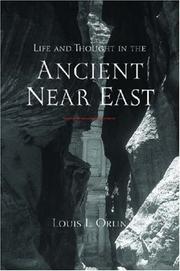
ISBN: 1282593951 9786612593956 0472025899 9780472025893 0472069926 0472099922 9780472069927 9780472099924 Year: 2007 Publisher: Ann Arbor : University of Michigan Press,
Abstract | Keywords | Export | Availability | Bookmark
 Loading...
Loading...Choose an application
- Reference Manager
- EndNote
- RefWorks (Direct export to RefWorks)
Book
ISBN: 2705306706 2351594622 9782705306700 Year: 1992 Volume: 133 Publisher: Paris: Geuthner,
Abstract | Keywords | Export | Availability | Bookmark
 Loading...
Loading...Choose an application
- Reference Manager
- EndNote
- RefWorks (Direct export to RefWorks)
This work is an attempt to apply the serial method to the study of the countryside in Roman and Byzantine times, in a region of northern Syria: the Limestone Massif, where very large numbers of remains and in excellent state of conservation of ancient villages and their parcels. In this region forty-six villages were selected as a sample. They are divided into three groups, where they form complete sets, in the ğebels Simā'n, Bārīšā, Il A'la and Zāwiye. They total 4,700 rooms reserved for men's homes and as many intended for economic functions, ie a population which must have peaked at around 20,000 inhabitants. Beyond the permanence of the agrarian landscapes and the main characteristics of the economy and society, this region experienced two major phases of expansion, one until the middle of the third century, the other from 330 to 550.The second phase, the best known, is marked by a considerable increase in the number of men and by an economic progress which has taken on an extensive form, enlargement of the land, then intensive, diversification of production with a view to sale. All in all, this population grew, while growing richer, in a context of urban expansion, which proves that the wealth of the cities and that of the countryside, far from being mutually exclusive, were complementary. In the middle of the sixth century, the gap widened between the number of men, which still tended to increase, and resources which levelled off, resulting in a long period of economic stagnation and impoverishment marked, in the short term, by severe subsistence crises and epidemics. Construction activity stops but the villages remain densely populated. The Islamic conquest does not entail any major consequences in the material life of the peasants. Their abandonment will not begin until the beginning of the 8th century, with the decline of the Umayyad Caliphate.
Excavations (Archaeology) --- -Syria --- Antiquities. --- Syria --- Antiquities --- Regions & Countries - Asia & the Middle East --- History & Archaeology --- Middle East --- Excavations (Archaeology) - Syria. --- Syrie --- Empire romain --- Syrie antique --- Moyen-Orient antique --- Empire byzantin --- géographie historique --- archéologie
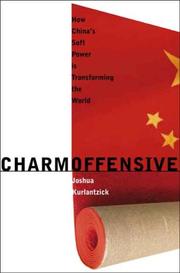
ISBN: 1281735345 9786611735340 0300137915 9780300137910 9780300131581 0300131585 9781281735348 9780300117035 0300117035 6611735348 9780300131543 0300131542 9780300136289 0300136285 Year: 2007 Publisher: New Haven : Yale University Press,
Abstract | Keywords | Export | Availability | Bookmark
 Loading...
Loading...Choose an application
- Reference Manager
- EndNote
- RefWorks (Direct export to RefWorks)
At the beginning of the twenty-first century, China is poised to become a major global power. And though much has been written of China's rise, a crucial aspect of this transformation has gone largely unnoticed: the way that China is using soft power to appeal to its neighbors and to distant countries alike.This book is the first to examine the significance of China's recent reliance on soft power—diplomacy, trade incentives, cultural and educational exchange opportunities, and other techniques—to project a benign national image, position itself as a model of social and economic success, and develop stronger international alliances. Drawing on years of experience tracking China's policies in Southeast Asia, Latin America, and Africa, Joshua Kurlantzick reveals how China has wooed the world with a'charm offensive'that has largely escaped the attention of American policy makers.Beijing's new diplomacy has altered the political landscape in Southeast Asia and far beyond, changing the dynamics of China's relationships with other countries. China also has worked to take advantage of American policy mistakes, Kurlantzick contends. In a provocative conclusion, he considers a future in which China may be the first nation since the Soviet Union to rival the United States in international influence.
Regions & Countries - Asia & the Middle East --- History & Archaeology --- East Asia --- International relations. --- China --- Relations. --- Coexistence --- Foreign affairs --- Foreign policy --- Foreign relations --- Global governance --- Interdependence of nations --- International affairs --- Peaceful coexistence --- World order --- Relations --- National security --- Sovereignty --- World politics
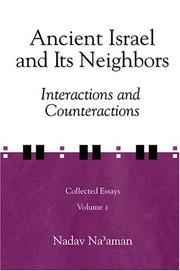
ISBN: 157506569X 9781575065694 1575061082 9781575061085 9781575061146 1575061147 Year: 2006 Publisher: Winona Lake, Indiana : Eisenbrauns,
Abstract | Keywords | Export | Availability | Bookmark
 Loading...
Loading...Choose an application
- Reference Manager
- EndNote
- RefWorks (Direct export to RefWorks)
Throughout the past three decades, Nadav Na’aman has repeatedly proved that he is one of the most careful historians of ancient Canaan and Israel. With broad expertise, he has brought together archaeology, text, and the inscriptional material from all of the ancient Near East to bear on the history of ancient Israel and the land of Canaan during the second and first millenniums B.C.E. Many of his studies have been published as journal articles or notes and yet, together, they constitute one of the most important bodies of literature on the subject in recent years, particularly because of the careful attention to methodology that Na’aman always has brought to his work.This final volume in the 3-volume set of Na’aman’s collected essays contains 29 essays. Among the topics addressed are: the sources available to Israel’s historians late in the first millennium B.C.E.; the reality behind the narratives relating to the history of the United Monarchy; the effect of the author’s own time on the composition of the histories of Saul, David, and Solomon; and the contributions of archaeology to the study of the tenth century B.C.E. In the course of covering these themes, Na’aman touches on topics such as history and historiography, textual and literary problems, historical geography, society, administration, cult, and religion.
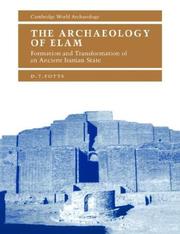
ISBN: 0521564964 9780521564960 0521563585 0511016050 0511323301 0511173105 051105355X 0511152078 0511489617 1280429119 9780521563581 9780511489617 1107113253 9780511016059 9786610429110 6610429111 0521563385 Year: 1999 Volume: *6 Publisher: Cambridge : Cambridge University Press,
Abstract | Keywords | Export | Availability | Bookmark
 Loading...
Loading...Choose an application
- Reference Manager
- EndNote
- RefWorks (Direct export to RefWorks)
From the middle of the 3rd millennium BC until the coming of Cyrus the Great, southwestern Iran was referred to in Mesopotamian sources as the land of Elam. A heterogeneous collection of regions, Elam was home to a variety of groups, alternately the object of Mesopotamian aggression, and aggressors themselves; an ethnic group seemingly swallowed up by the vast Achaemenid Persian empire, yet a force strong enough to attack Babylonia in the last centuries BC. The Elamite language is attested as late as the Medieval era, and the name Elam as late as 1300 in the records of the Nestorian church. This book examines the formation and transformation of Elam's many identities through both archaeological and written evidence, and brings to life one of the most important regions of Western Asia, re-evaluates its significance, and places it in the context of the most recent archaeological and historical scholarship.
Elam --- Antiquities. --- History. --- Antiquités --- Histoire --- History --- Antiquities --- Elam-- Antiquities. --- Regions & Countries - Asia & the Middle East --- History & Archaeology --- Middle East --- -Elam --- -Antiquities --- Antiquités --- Susiana --- -Susiana --- Elimais --- Elamtu --- Elymaide --- Elamite --- Eilam --- Ilam --- Excavations (Archaeology) --- Archaeological digs --- Archaeological excavations --- Digs (Archaeology) --- Excavation sites (Archaeology) --- Ruins --- Sites, Excavation (Archaeology) --- Archaeology --- Social Sciences --- Archeology --- Elam - History --- Elam - Antiquities
Multi
ISSN: 01699423 01699423 ISBN: 9004229434 9789004229433 9789004228450 9004228454 Year: 2014 Volume: 106 106 Publisher: Leiden : Brill,
Abstract | Keywords | Export | Availability | Bookmark
 Loading...
Loading...Choose an application
- Reference Manager
- EndNote
- RefWorks (Direct export to RefWorks)
The historical and cultural role of the Aramaeans in ancient Syria can hardly be overestimated. Thus The Aramaeans in Ancient Syria gives precise and up-to-date information on different aspects of Aramaean culture. To that end, history, society, economy and law, language and script, literature, religion, art and architecture of the Aramaean kingdoms of Syria from their beginnings in the 11 century B.C. until their end at approximately 720 B.C. are covered within the handbook. The wide survey of Aramaean culture in Syria is supplemented by overviews on the Aramaeans in Assyria, Babylonia, Phoenicia, Palestine, Egypt, North Arabia and on the Aramaean heritage in the Levant.
Arameans --- Regions & Countries - Asia & the Middle East --- History & Archaeology --- Middle East --- History --- Social life and customs --- History. --- Social life and customs. --- Syria --- Ethnology --- Civilization --- Arameans. --- Araméens --- Syrie --- Histoire --- Arameans - Syria - History --- Arameans - Syria - Social life and customs --- Syria - History - To 333 B.C.
Book
ISBN: 888453139X 8884531403 Year: 2004 Volume: 2 Publisher: Firenze University Press
Abstract | Keywords | Export | Availability | Bookmark
 Loading...
Loading...Choose an application
- Reference Manager
- EndNote
- RefWorks (Direct export to RefWorks)
In the undulating plains of north-eastern Syria is the site of Tell Barri, identified with the city of Kahat. The archaeological sequence which has been brought to light stretches without interruption from the start of the third millennium up to the fourteenth century AD. This report records the results of the seventeenth excavation campaign, carried out by the group from the University of Florence and from the “Federico II” University of Naples. Layers from the end of the third millennium have been brought to light, the passage between the Mid- and Neo-Assyrian periods. In the palace of Tukulti-Ninurta II the reception hall was discovered. For the later periods, investigation has proceeded on the Great Defensive Wall of Parthian age, and on the large edifice in the lower city.
Excavations (Archaeology) --- Regions & Countries - Asia & the Middle East --- History & Archaeology --- Middle East --- Barri, Tell (Syria) --- Syria --- Antiquities. --- Archaeological digs --- Archaeological excavations --- Digs (Archaeology) --- Excavation sites (Archaeology) --- Ruins --- Sites, Excavation (Archaeology) --- Kaḫat (Syria) --- Tall Barri (Syria) --- Tell Barri (Syria) --- Archaeology --- Antiquities --- archaeological excavations --- archaeological sources --- tell barri --- scavi archeologici --- fonti archeologiche --- kahat
Book
ISBN: 8884532921 8884532922 8884532914 Year: 2005 Volume: 3 Publisher: Firenze University Press
Abstract | Keywords | Export | Availability | Bookmark
 Loading...
Loading...Choose an application
- Reference Manager
- EndNote
- RefWorks (Direct export to RefWorks)
In the undulating plains of north-eastern Syria is the site of Tell Barri, identified with the city of Kahat. The archaeological sequence which has been brought to light stretches without interruption from the start of the third millennium up to the fourteenth century AD. This report records the results of the eighteenth excavation campaign, carried out by the group from the University of Florence and from the "Federico II" University of Naples. In Area G, the excavation of the chapel dating to the third millennium proceeded, bringing to light a palatine building that can be attributed to the Mid Assyrian King Adad-Nirari I. In Areas A and J, the Parthian, Hellenistic and Achemenidian layers were excavated up to the level of the Neo-Babylonian reoccupation of the Assyrian palace of Tukulti-Ninurta II. As regards the Parthian phase, investigation has proceeded on the Great Defensive Wall and on the large edifice in the lower city. The text, delivered for printing in July 2005, was published following the tragic death of Paolo Emilio Pecorella, which took place on 29 August in Tell Barri, in the course of the excavation campaign. Nelle ondulate pianure della Siria nord-orientale si trova il sito di Tell Barri, identificato con la città di Kahat. La sequenza archeologica portata alla luce va dall'inizio del III millennio sino al XIV secolo d.C, senza soluzione di continuità. La presente relazione dà ragione dei risultati della diciottesima campagna di scavo ad opera del gruppo dell'Università di Firenze e dell'Università 'Federico II' di Napoli. Nell'Area G è proseguito lo scavo del sacello del III millennio e si è messo in luce un edificio palatino attribuibile al re medio assiro Adad-Nirari I; nelle Aree A e J sono stati scavati gli strati partici, ellenistici ed achemenidi, sino al livello della rioccupazione neobabilonese del palazzo assiro di Tukulti-Ninurta II. Per la fase partica è proseguita l'indagine sia del Grande Muro di Difesa sia del grande edificio della città bassa. Il testo, consegnato per la stampa a luglio del 2005, vede la luce dopo la tragica scomparsa di Paolo Emilio Pecorella, avvenuta il 29 agosto a Tell Barri, nel corso della campagna di scavo.
Excavations (Archaeology) --- Regions & Countries - Asia & the Middle East --- History & Archaeology --- Middle East --- Barri, Tell (Syria) --- Syria --- Antiquities. --- Archaeological digs --- Archaeological excavations --- Digs (Archaeology) --- Excavation sites (Archaeology) --- Ruins --- Sites, Excavation (Archaeology) --- Kaḫat (Syria) --- Tall Barri (Syria) --- Tell Barri (Syria) --- Archaeology --- Antiquities --- archaeological excavations --- archaeological sources --- tell barri --- scavi archeologici --- fonti archeologiche --- kahat
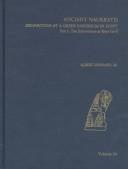
ISBN: 0788503928 0897570251 9780788503924 9780897570251 Year: 2001 Volume: . 1 54-55 Publisher: Boston: Atlanta, GA: American schools of Oriental research, Scholars Press,
Abstract | Keywords | Export | Availability | Bookmark
 Loading...
Loading...Choose an application
- Reference Manager
- EndNote
- RefWorks (Direct export to RefWorks)
Excavations (Archaeology) --- Naucratis (Extinct city) --- 902 <32 NAUKRATIS> --- Archeologie--Oud-Egypte--NAUKRATIS --- Naucratis (Ancient city) --- Naukratis (Extinct city) --- -Archeologie--Oud-Egypte--NAUKRATIS --- 902 <32 NAUKRATIS> Archeologie--Oud-Egypte--NAUKRATIS --- -Archaeological digs --- Archaeological excavations --- Digs (Archaeology) --- Excavation sites (Archaeology) --- Ruins --- Sites, Excavation (Archaeology) --- Archaeology --- Egypt --- Antiquities --- SOCIAL SCIENCE --- Regions & Countries - Africa --- Middle East --- History & Archaeology --- Regions & Countries - Asia & the Middle East --- Excavations (Archaeology) - Egypt - Naucratis (Extinct city) --- -Naucratis (Extinct city)

ISSN: 15686183 ISBN: 1281926493 9786611926496 904742168X 9789047421689 9789004158139 9004158138 9781281926494 6611926496 Year: 2007 Volume: v. 15 Publisher: Leiden ; Boston : Brill,
Abstract | Keywords | Export | Availability | Bookmark
 Loading...
Loading...Choose an application
- Reference Manager
- EndNote
- RefWorks (Direct export to RefWorks)
This book presents the first comprehensive anthropological account of premodern Tibetan pastoral economy and social organization in the Kham region of eastern Tibet. It offers a uniquely fine-grained descriptive portrait of traditional Tibetan rural life among nomads in the kingdom of Dege. Based upon extensive ethnographic interviews, this study yields a nuanced analysis of the most crucial and controversial relationship in premodern Tibetan societies, namely, that ensuing between local lords and their dependents. It convincingly readdresses anthropological debates and political claims about feudalism or serfdom in Tibetan societies from a perspective that is more sensitive to local historical, social, and economic contexts.
Dege Xian (China) -- Economic conditions. --- Dege Xian (China) -- Social life and customs. --- Herding -- China -- Dege Xian. --- Nomads -- China -- Dege Xian -- Economic conditions. --- Nomads -- China -- Dege Xian -- Social life and customs. --- Social structure -- China -- Dege Xian. --- Nomads --- Herding --- Social structure --- Regions & Countries - Asia & the Middle East --- History & Archaeology --- East Asia --- Social life and customs --- Economic conditions --- Social life and customs. --- Economic conditions. --- Dege Xian (China) --- Organization, Social --- Social organization --- Nomadic peoples --- Nomadism --- Pastoral peoples --- Vagabonds --- Wanderers --- Te-ko hsien (China) --- Tehko (China) --- Sde-dge (China) --- Dege Gonchen (China) --- Dege (China) --- Anthropology --- Sociology --- Social institutions --- Animal culture --- Pastoral systems --- Persons --- Herders --- Nomades --- Structure sociale --- Moeurs et coutumes --- Conditions économiques
| Listing 1 - 10 of 14 | << page >> |
Sort by
|

 Search
Search Feedback
Feedback About UniCat
About UniCat  Help
Help News
News